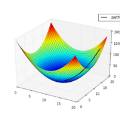We propose the gradient-weighted Object Detector Activation Maps (ODAM), a visualized explanation technique for interpreting the predictions of object detectors. Utilizing the gradients of detector targets flowing into the intermediate feature maps, ODAM produces heat maps that show the influence of regions on the detector's decision for each predicted attribute. Compared to previous works classification activation maps (CAM), ODAM generates instance-specific explanations rather than class-specific ones. We show that ODAM is applicable to both one-stage detectors and two-stage detectors with different types of detector backbones and heads, and produces higher-quality visual explanations than the state-of-the-art both effectively and efficiently. We next propose a training scheme, Odam-Train, to improve the explanation ability on object discrimination of the detector through encouraging consistency between explanations for detections on the same object, and distinct explanations for detections on different objects. Based on the heat maps produced by ODAM with Odam-Train, we propose Odam-NMS, which considers the information of the model's explanation for each prediction to distinguish the duplicate detected objects. We present a detailed analysis of the visualized explanations of detectors and carry out extensive experiments to validate the effectiveness of the proposed ODAM.
翻译:我们提出了基于梯度的Object Detector Activation Maps(ODAM),一种用于解释目标检测器的预测的可视化技术。ODAM利用流向中间特征图的检测器目标的梯度,生成热力图,显示对每个预测属性的检测器决策的区域影响。与之前的分类激活图(CAM)相比,ODAM生成的是单个目标的解释而不是类别特异性的解释。我们展示了ODAM适用于不同类型的检测器骨干和头的单阶段检测器和双阶段检测器,并且在效果和效率上比最先进的技术都更优秀。接下来,我们提出了一个训练方案Odam-Train,通过鼓励同一对象的检测的解释之间的一致性和不同对象的检测的区别来提高检测器对目标识别的解释能力。基于ODAM和Odam-Train生成的热力图,我们提出了Odam-NMS,该方法考虑模型对每个预测的解释信息,以区分重复的检测目标。我们对检测器的可视化解释进行了详细的分析,并进行了广泛的实验来验证ODAM的有效性。



